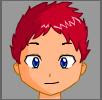Parts of Speech:
The Japanese language is comprised of verbs, adjectives, nouns, adverbs, conjunctions, and particles.
Word Order:
A predicate always comes at the end of a sentence. A modifier always comes before the word or phrase to be modified.
Predicate:
There are three types of predicates in Japanese: noun, verb, and adjective. A predicate inflects according to whether it is (1) affirmative or negative, and (2) non-past or past.
Adjectives are divided into two types according to their type of inflection. They are called "i"-adjectives and "na" adjectives. (There are symbols for both of these that I'll post in a bit)
In Japanese, words do not inflect for person, gender, or number.
Particle:
A particle is used to show the grammatical relation between words, to show the speaker's intention or to connect sentences.
Omission:
Words or phrases are often omitted if they are understood from the context. Even the subject and object of a sentence are often omitted.
Japanese Script
There are three knds of letters in Japanese: hiragana, katakana, and kanji (Chinese characters). Hiragana and katakana are phonetic representations of sounds, and each letter basically corresponds to one mora (a unit of sound, see picture post in a sec). Kanji convey meanings as well as sounds.
In Japanese script, all three types of letters are used together. Katakana are used to write foreign names and loan words. 1945 kanji letters are fixed as essential for daily use. Hiragana are used to write particles, the inflectable parts of words, etc. Other than these three types of letters, romaji (Roman letters) are sometimes used for the convenience of foreigners. You may see romaji at stations and on sign-boards.
"Romaji" more or less describes all the words in my previous posts, basically a Romanized phonetic spelling of the individual word(s), for instance "watashi wa" or whatever.
Kana and Mora (Click on picture for full view, it is a chart of Hiragana, Katakana, and Romaji all marked out by pronounciation. This is one of the single most useful things you will ever find, so try to learn as much as you can.)

I'll add more later.
